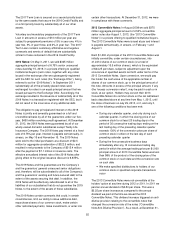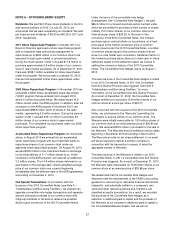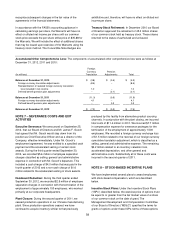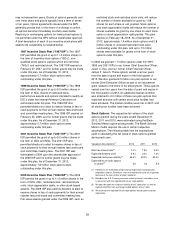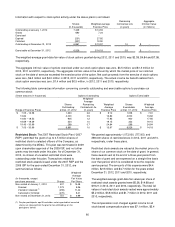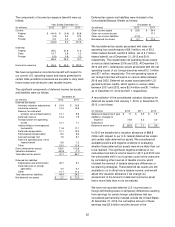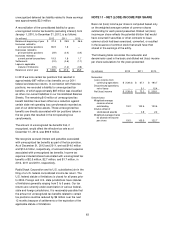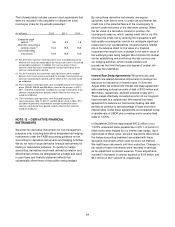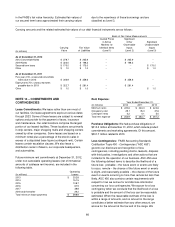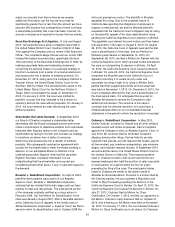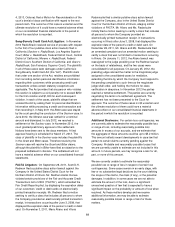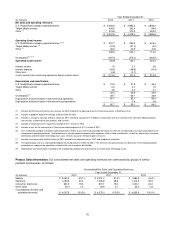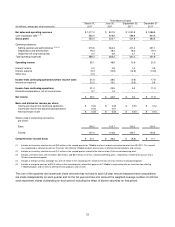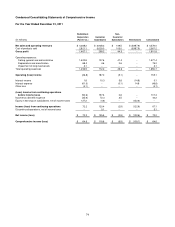Radio Shack 2012 Annual Report Download - page 66
Download and view the complete annual report
Please find page 66 of the 2012 Radio Shack annual report below. You can navigate through the pages in the report by either clicking on the pages listed below, or by using the keyword search tool below to find specific information within the annual report.
64
The following table includes common stock equivalents that
were not included in the calculation of diluted net (loss)
income per share for the periods presented:
(In millions)
2012
2011
2010
Employee stock
options (1) (2)
6.9
6.3
1.8
Warrants to purchase
common stock (3)
15.8
15.8
15.5
Convertible debt
Instruments (4)
15.8
15.8
15.5
(1)
For 2012 these common stock equivalents were excluded because the
effect of their inclusion would reduce our net loss per share in thi
s period
and would be antidilutive. In addition, the exercise prices of these
common stock equivalents exceeded the average market price of our
common stock during this period.
(2)
For 2011 and 2010, these common stock equivalents were excluded
because their exercise prices exceeded the average market price of our
common stock during this period, and the effect of their inclusion would
be antidilutive.
(3)
These common stock equivalents were excluded because their exercise
prices ($35.88, $35.88, and $36.60 per share for the warrants in 2012,
2011, and 2010, respectively) exceeded the average market price of our
common stock during these periods, and the effect of their inclusion
would be antidilutive.
(4)
These common stock equivalents were excluded because the
conversion prices ($23.77, $23.77, and $24.25 per share in 2012, 2011,
and 2010, respectively) exceeded the average market price of our
common stock during these periods, and the effect of their inclusion
would be antidilutive.
NOTE 12 – DERIVATIVE FINANCIAL
INSTRUMENTS
We enter into derivative instruments for risk management
purposes only, including derivatives designated as hedging
instruments under the FASB accounting guidance on the
accounting for derivative instruments and hedging activities.
We do not hold or issue derivative financial instruments for
trading or speculative purposes. To qualify for hedge
accounting, derivatives must meet defined correlation and
effectiveness criteria, be designated as a hedge and result
in cash flows and financial statement effects that
substantially offset those of the position being hedged.
By using these derivative instruments, we expose
ourselves, from time to time, to credit risk and market risk.
Credit risk is the potential failure of the counterparty to
perform under the terms of the derivative contract. When
the fair value of a derivative contract is positive, the
counterparty owes us, which creates credit risk for us. We
minimize this credit risk by entering into transactions with
high quality counterparties and do not anticipate significant
losses due to our counterparties’ nonperformance. Market
risk is the adverse effect on the value of a financial
instrument that results from a change in the rate or value of
the underlying item being hedged. We minimize this market
risk by establishing and monitoring internal controls over
our hedging activities, which include policies and
procedures that limit the types and degree of market risk
that may be undertaken.
Interest Rate Swap Agreements: We previously used
interest rate-related derivative instruments to manage our
exposure to fluctuations of interest rates. In June and
August 2003, we entered into interest rate swap agreements
with underlying notional amounts of debt of $100 million and
$50 million, respectively, and both matured in May 2011.
These swaps effectively converted a portion of our long-term
fixed rate debt to a variable rate. We entered into these
agreements to balance our fixed versus floating rate debt
portfolio to continue to take advantage of lower short-term
interest rates. Under these agreements, we contracted to pay
a variable rate of LIBOR plus a markup and to receive fixed
rates of 7.375%.
In September 2009 we repurchased $43.2 million of our
7.375% unsecured notes payable due in 2011. A portion of
these notes were hedged by our interest rate swaps. Upon
repurchase of these notes, we were required to discontinue
the hedge accounting treatment associated with these
derivative instruments which used the short-cut method.
We held these instruments until their maturities. Changes in
fair value of these instruments were recorded in earnings
as an adjustment to interest expense. These adjustments
resulted in increases in interest expense of $1.9 million and
$3.4 million in 2011 and 2010, respectively.



